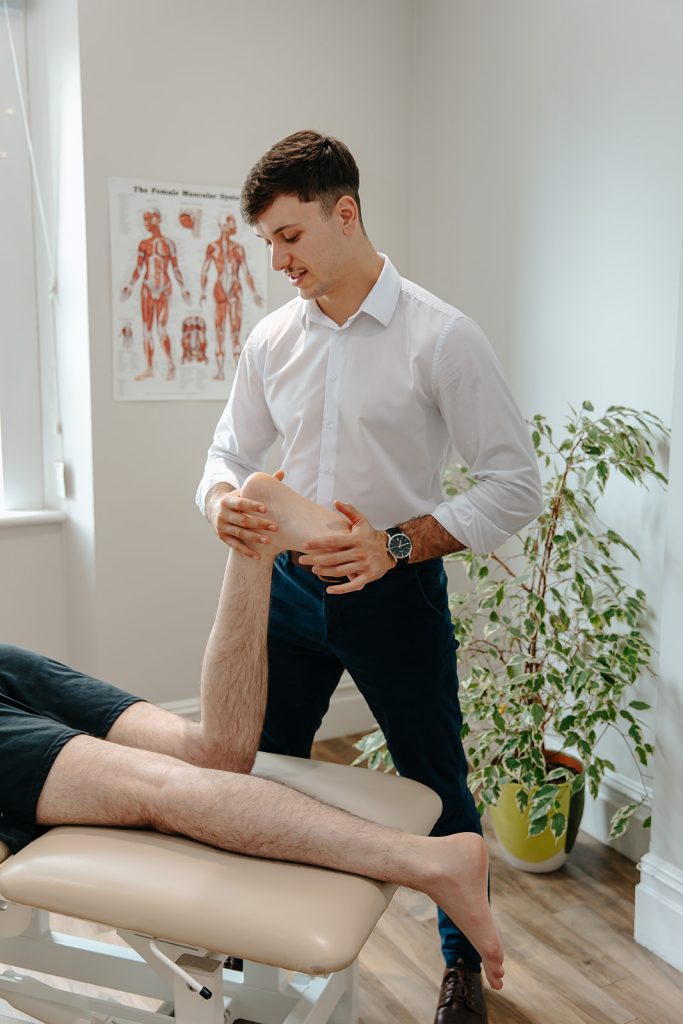Steph Hatt
October 22, 2018

SCIATICA PAIN TREATMENT
Are you suffering from sciatica pain that radiates down your leg, making it difficult to walk or perform daily activities?
Our sciatica specialists understand the challenges posed by this condition and offer the sciatica pain treatment you need to find lasting relief.
They’re experts in diagnosing and treating sciatica and will tailor your sciatica physio to meet your unique needs.
Are you:
Ready to take the first step toward pain-free living and improved mobility?
Book your sciatica physio appointment today and discover the difference a sciatica specialist can make in your life.

Visit a sciatica specialist at our Devizes clinic in Couch Lane.

Visit a sciatica specialist at our Frome clinic in Wallbridge.

Visit a sciatica specialist at our Marlborough clinic in Hughenden Yard.


Sciatica can affect people of all ages but certain factors may increase the likelihood of experiencing sciatica. The condition most commonly affects adults between the ages of 30 and 60 years old, pregnant women, and individuals that spend a prolonged amount of time sitting or heavy lifting throughout the day.
There are many different causes of sciatica including:
– A herniated or prolapsed disc (commonly known as ‘slipped disc’). Vertebral discs are found between each vertebrae in your spine. Although they are made of tough fibrous tissue, some of the softer centre can prolapse. If you have a prolapsed vertebral disc, its contents can protrude and compress on the sciatic nerve, or even just cause chemical irritation to the nerve. All of these can lead to sciatica.
– Piriformis syndrome. The piriformis is a muscle found deep in the buttock. In around 17% of the population, the sciatic nerve runs directly through the piriformis. If the piriformis becomes tight then this can compress the sciatic nerve causing sciatic tension and sciatica.
– Facet joint dysfunction. Each of the vertebrae in your spine is joined by facet joints (or zygapophyseal joints). A sudden excessive movement of the facet joint or years of constant micro trauma through poor posture or heavy lifting can lead to facet joint dysfunction. This can be a cause of radiating leg pain (sciatica).
Find out more about our treatment options that can help with back pain:
We’ll start by understanding your medical history
We’ll then identify the cause of your sciatic pain and give you a clear diagnosis
You’ll receive hands on treatment to relieve any sharp, shooting pain
We’ll put together a personalised treatment plan to manage your sciatica
You’ll receive ongoing support from our team to prevent the recurrence of sciatica



Sciatica refers to pain that radiates along the path of the sciatic nerve, which branches from your lower back through your hips and buttocks and down each leg. Sciatica typically affects only one side of your body and can range from a mild ache to sharp, severe pain.
Sciatica is often caused by a herniated disk, bone spurs on the spine, or narrowing of the spine. Treatment may include medication, physiotherapy, and in severe cases, surgery.
In some cases, sciatica may only last a few weeks, while in others it can persist for several months or even longer. It may improve on its own with time and treatments. But for some people, the pain and discomfort of sciatica may be chronic and require ongoing care.
There are several ways to help relieve sciatica pain, including:
– Hot or cold therapy: Applying heat or ice to the affected area can help reduce inflammation and relieve pain
– Exercise: Low-impact exercises like walking, swimming, or yoga can help improve flexibility and strength, which can alleviate sciatic pain
– Medication: Over-the-counter pain relievers like ibuprofen can help reduce pain and inflammation. In some cases, prescription medications may be necessary
– Physiotherapy: A physiotherapist can provide exercises and techniques to help reduce pain and strengthen the muscles surrounding the sciatic nerve
– Massage therapy: Massage can help relax tight muscles and reduce pressure on the sciatic nerve
– Acupuncture: Acupuncture involves inserting thin needles into specific points on the body to help relieve pain and improve overall health
Buttock pain typically occurs due to compression or irritation of the sciatic nerve. This can be caused by a variety of factors such as a herniated disk, spinal stenosis, piriformis syndrome, or even a muscle strain. In some cases, underlying medical conditions such as diabetes or obesity can also contribute to sciatic nerve pain.
Sciatica typically feels like a sharp, shooting pain that radiates down one leg. It can also cause numbness, tingling, or weakness in the affected leg. The pain can be intense and debilitating, making it difficult to sit, stand, or walk. It is often caused by compression or irritation of the sciatic nerve, which runs from the lower back down the back of each leg.
Symptoms of sciatica include:
– Pain in the lower back that radiates down the leg
– Numbness or tingling in the leg or foot
– Weakness in the leg or foot
– Shooting pain that makes it difficult to stand or walk
– Muscle weakness in the affected leg
– Pain that worsens with sitting or standing for long periods of time
– Burning or prickling sensation in the leg or foot
Sciatica can go away on its own with time and self-care measures such as rest, gentle stretching, and over-the-counter pain medications. In some cases, physiotherapy, medication, or other interventions may be necessary to manage sciatica.
To relieve sciatica pain in bed, you can try the following methods:
– Use a firm mattress to provide support for your back
– Use a pillow between your knees when sleeping on your side to help align your spine
– Try sleeping on your back with a pillow under your knees to reduce pressure on the sciatic nerve
– Use heat or ice packs on the affected area to reduce inflammation and pain
– Practice gentle stretches and exercises recommended by a healthcare professional to help alleviate pain
– Make sure to maintain good posture while in bed and throughout the day to prevent further aggravation.
– Make sure you are taking adequate pain relief – this can be over the counter medication or sometimes in severe cases prescribed medication
Sciatica pain is caused by irritation of the sciatic nerve, which is the largest nerve in the body. This irritation can be caused by a herniated or bulging disc, spinal stenosis, bone spurs, muscle strain, or other conditions that put pressure on the nerve. The pain can range from mild to severe and is often felt in the lower back, buttocks, and down the leg. In some cases, the pain can be accompanied by numbness, tingling, or weakness in the affected leg.
Swimming can be a good form of exercise for people with sciatica because it is low-impact and gentle on the joints. However, before swimming you should seek advice form a health care professional to ensure it is the right exercise for you.
Walking can be a good form of exercise for people with sciatica – keeping you mobile , fit and active. However, before starting any prolonged walking you should seek advice from a health care professional to ensure it is the right exercise for you.
While it is most common for sciatica to affect only one leg, it is also possible for symptoms to occur in both legs. This is known as bilateral sciatica, and it can be caused by a variety of factors.
Many people have found relief from sciatica pain through acupuncture treatments, as it can help reduce inflammation, improve blood flow, and relax muscles in the affected area.
Sciatica is typically caused by irritation or compression of the sciatic nerve, which runs from the lower back down through the hips and buttocks and down the back of each leg. This can result in pain, numbness, or tingling in the hip area.
Like swimming, cycling can be a great way to exercise if you suffer with sciatica, as it is a low-impact activity that can help to alleviate some of the pain associated with sciatica.
If you are experiencing pain from sciatica while trying to sleep, there are a few techniques that may help alleviate discomfort:
– Find a comfortable sleeping position: Try sleeping on your side with a pillow between your knees, or on your back with a pillow under your knees to help relieve pressure on your lower back
– Use supportive bedding: Invest in a good mattress and pillows that provide proper support for your spine
– Apply heat or cold therapy: Use a heating pad or ice pack on the affected area before bed to help reduce inflammation and soothe the pain
– Practice relaxation techniques: Try deep breathing exercises, meditation, or gentle stretching before bed to help relax your muscles and ease tension
– Take over-the-counter pain medication: If the pain is severe, you may consider taking pain relief medication as recommended by your doctor
If your sciatica pain persists and affects your sleep regularly, consult with a healthcare professional for further evaluation and treatment options.
Sitting with sciatica can be challenging, but there are a few tips to help alleviate discomfort.
– Use a supportive chair with proper lumbar support to maintain good posture
– Sit with your knees at a 90-degree angle and keep your feet flat on the floor
– Avoid sitting for prolonged periods of time. Take breaks to stand up, stretch, and walk around
– Use a lumbar support to support your lower back or under your hips to relieve pressure on your sciatic nerve
– Consider using a standing desk or adjustable desk to alternate between sitting and standing throughout the day
– Practice good posture and avoid slouching to prevent additional strain on your back
When it comes to sciatica, an osteopath may be able to help in several ways. First, they can conduct a thorough assessment to determine the root cause of the sciatic pain. This may involve examining the spine, pelvis, and legs to identify any misalignments or muscle imbalances that could be contributing to the symptoms. Once the underlying issues are identified, an osteopath can use hands-on techniques to help alleviate the pain and improve mobility.
Sciatica is not specifically hereditary, as it is not a genetic condition that is passed down from parents to children. Though, certain risk factors for developing sciatica, such as obesity, age, and occupations that require heavy lifting or prolonged sitting, can run in families. If you have a family history of sciatica or back problems, you may be at a higher risk of developing it yourself.
You can NOT experience ‘sciatica’ in your arm, as the sciatic nerve does not extend into the arms. Instead, it could be a sign of a trapped nerve elsewhere – such as the neck. This can also cause similar symptoms of pain, tingling, numbness, weakness, or shooting sensations in the arm.
Sciatica is usually diagnosed through a physical exam and a review of the patient’s medical history by a health professional. Imaging tests such as X-rays, MRI scans, or CT scans may can also be used to identify the cause of the sciatic nerve pain.
Our team of experienced healthcare professionals specialise in diagnosing sciatica. Once a diagnosis has been confirmed, our team will work closely with the patient to develop a comprehensive treatment plan.
For those who suffer from sciatica, running can be a challenge, as depending on its cause – can exacerbate symptoms of sciatica. You should seek professional help forma Physiotherapist to provide further guidance
Sciatica can indeed cause knee pain. The sciatic nerve is a long nerve that runs from the lower back down to the feet, and it branches off into smaller nerves that innervate different parts of the leg, including the knee. When the sciatic nerve is compressed or irritated, it can cause radiating pain that can be felt in the knee.
Heat therapy is a common treatment option for relieving the symptoms of sciatica. Heat can help to relax tight muscles and increase blood flow to the affected area, and alleviate pain. Heat therapy can take many forms, including hot packs, heating pads, warm baths, or even warm compresses.
Yoga has been praised for its numerous health benefits, including its ability to alleviate symptoms of sciatica. Sciatica is a condition characterised by pain that radiates along the path of the sciatic nerve, which runs from your lower back down through your hips and buttocks and into each leg.
Pilates can be a beneficial form of exercise for individuals suffering from sciatica. It focuses on strengthening the core muscles, improving flexibility, and promoting proper alignment and posture, all of which can help alleviate the symptoms of sciatica.
There are several treatment options that may help with sciatica pain, including:
1. Exercise: Regular physical activity can help improve flexibility, strengthen muscles, and reduce inflammation in the affected area
2. Hot and cold therapy: Applying a heating pad or ice pack to the affected area can help reduce pain and inflammation
3. Pain medication: Over-the-counter or prescription pain medications may help alleviate sciatica pain
4. Physiotherapy: A physiotherapist can provide exercises and techniques to help relieve sciatica pain
5. Injection therapy: Corticosteroid injections can help reduce inflammation in the affected area and provide temporary pain relief
6. Alternative therapies: Some people find relief with acupuncture, chiropractic care, or massage therapy
7. Surgery: In severe cases, surgery may be recommended to relieve pressure on the sciatic nerve
Massage therapy can help to relieve the symptoms of sciatica. By working on the muscles surrounding the sciatic nerve, massage can help reduce inflammation, improve blood flow, and release tension that may be contributing to the pain.